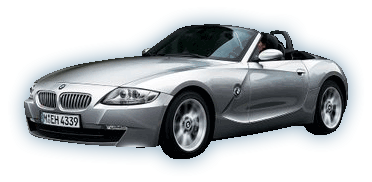

BMW Z4 (E85/86) 2002-2008
Oxidized Aluminum Kit
The oxidized aluminum kit is for BMW, Jaguar, Mercedes, Volvo, Saab, Volkswagen, and many others. This flexible deoxidizer lasts indefinitely. After the surfaces are prepared following the directions on the included DVD, the deoxidizer is applied with the applicator using a flow on motion. The oxidized look immediately disappears, leaving an original factory look.
The kit includes all materials necessary to achieve a professional end result.
This Kit is:
$49.95 Plus $10.00 Shipping.
We offer a 30 day money back guarantee.
Car chase scenes are toward the end of this video...
BMW Z4 (E85)
The first-generation of BMW Z4 was designed by Danish BMW-designer Anders Warming from 1998 to 2000. The Z4 was introduced at the Paris Auto Show in 2002, and went on sale in November of the same year for the 2003 model year. It is a physically larger, completely redesigned successor to the Z3. Initially, it was only available as a roadster with the 2.5L or 3.0L inline six-cylinder engines. Warming's design was controversial, as were many BMW designs of the time produced under the watch of BMW chief designer Chris Bangle.
The Z4's design addressed many criticisms of the preceding Z3; the Z4 is larger, and has a significantly stiffer chassis. The Z4 features a strut type front suspension like its predecessor. The rear suspension, however is considerably different from that of the Z3, which was based on that of the E30 BMW 3 Series. Instead of a semi-trailing arm suspension, the Z4 uses a more advanced multi-link suspension.
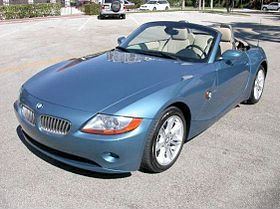
Features
The Z4 used lightweight materials to offset the increased weight over the smaller Z3, such as aluminum hood and suspension components, magnesium roof frame. Run flat tires removed the need for a spare tire, which in addition to saving weight, allowed for a larger boot.
Advanced aerodynamics yield a drag coefficient of 0.35 and a relatively calm passenger compartment when the top is down.
The 6-cylinder engines included all alloy construction, double VANOS variable valve timing and streamlined intake and exhaust manifolds, throttle by wire. Safety technology included four-wheel disc brakes and electronic stability control, incorporating ABS and traction control. The electric power steering was speed-sensitive, allowing for easier maneuvering at low speeds.
A "Sport Package" added stiffer and lower suspension, larger wheels, and sport tuned electronic steering, throttle and shift parameters.
The SMG transmission was offered in addition to the usual manual and automatic.
Production of a cheaper 2.2-litre model began in October 2003, priced from £18,500 in UK. It weighs 35 kg (77 lb) less than the 3.0L version, but is still heavier than the 2.5L Z3's weight of 1,315 kg (2,900 lb). A 2.0L 4-cylinder engine for the European market was introduced in May 2005.
Z4 Coupé (E86)
BMW unveiled a concept coupé version of the Z4 at the Frankfurt Motor Show in 2005. The design of the Z4 and Z4 coupé has variously been ascribed to Anders Warming, Chris Bangle, the controversial former BMW Head Designer, and Adrian van Hooydonk, current BMW design chief, and BMW designer Tomasz Sycha. The company announced in 2005 that the coupé would be available for production including the return of the M Coupé. The production cars were introduced at the New York Auto Show in April 2006.
The M Coupé shares its 3.2 L Inline-6 with the M Roadster. Thanks to its hatch design, the Z4 Coupé offers 10.1 cu ft (0.29 m3) of trunk space, as opposed to 8.5 cu ft (0.24 m3) for the roadster.
Manufacturer BMW
Also called Land Shark
Production 2002-08
Assembly Greer, Spartanburg County, South Carolina, United States (BMW US Mfg. Co.)
Predecessor BMW Z3
Successor BMW Z4 (E89)
Class Luxury Car-Sports Car-Roadster
Body style 2-door roadster
2-door coupé
Layout FMR layout
Engine
2.0 L N46B20 I4
2.2 L M54B22 I6
2.5 L M54B25 I6
3.0 L M54B30 I6
3.0 L N52B30 I6
3.2 L S54B32 I6
Transmission 5/6-speed manual
5/6-speed automatic
Wheelbase 2,495 mm (98.2 in)
Length 4,090 mm (161.0 in)
Width 1,780 mm (70.1 in)
Height 1,300 mm (51.2 in) (roadster)
1,285 mm (50.6 in) (coupe)
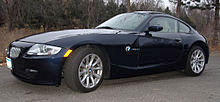
2007 Z4 3.0si Coupe (US)

Z4 coupe (US)
The E86 Coupé features a fixed hard-top roof which yields additional torsional rigidity—32,000 N·m (24,000 lb·ft) per degree of body twist on the coupe compared to 14,500 N·m (10,700 lb·ft) per degree on the roadster. This additional rigidity improves driving dynamics and corner handling. The roof now features a 'double bubble' contour which serves as an aerodynamic aid and offers more headroom than the roadster with top closed. The coupe has a sleek fastback rear window that slopes down to an integrated spoiler shaped to deliver downforce to the rear axle at speed.
Production:
Over the Z4 E86 life cycle (2006–2008), only 12,819 Z4 coupés (E86) were produced worldwide, as well as 4,275 Z4M coupés, yielding a total of 17,094 coupés (Z4 and Z4M).
BMW Concept Coupé Mille Miglia 2006
It is a concept car inspired by the BMW 328 Mille Miglia Touring Coupé, but uses Z4 M Coupé's drive components. The concept car is 23 cm longer, 14 cm wider, and 4 cm flatter than Z4 M Coupé. Other features of the concept car include 20-inch alloy wheels with 245/40R20 tires, permanently integrated sidewalls, swing-up cockpit, LED headlight panel, silver-coloured carbon-fibre reinforced plastic body, 3-material (stainless steel, untreated cowhides and Lycra fabric) interior.
The vehicle was designed by Anders Warming.
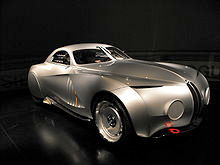
BMW Concept Coupé Mille Miglia 2006, BMW Museum, Munchen, Germany.
2006 update
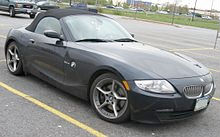
2006–2008 BMW Z4 3.0si
In 2006, BMW updated the Z4 line by introducing the M Roadster, and later the M Coupe, with the vaunted S54 "M" engine. The standard cars received the new N52 I6 engines. The N52 features a magnesium block construction, which consists of an aluminium interior for the cylinders, and an outer magnesium block. The engine features BMW's Valvetronic variable valve timing system for increased performance, are considerably more powerful through the middle of the rev range, and also improve fuel economy noticeably. A final benefit of the N52 engines is that they improve handling and turn-in due to the decreased weight over the nose of the car. This is particularly noticeable when compared to the Z4 M, which continued with the heavier S54 iron block engine.
Standard equipment include Run Flat tires, ABS Brakes, Stability Control, Traction Control, CD Player, Power Locks, Power Windows and Air Conditioning. The Z4 included Side Airbags, Driver Airbags, Passenger AirBags, Knee Airbags and 5 Star Rollover Protection.
In addition to the powertrain updates, BMW made mild revisions to the styling of the Z4, added several electronic features, and increased the brake size on the 3.0si models.
The 2006 BMW Z4 received a number of updates including a revised exterior, more powerful engines and improved interior features. Highlighted by a new front bumper ensemble with a larger air intake, rectangular foglights and front side reflectors, the exterior also received new wheels, rear bumper and taillight designs. The interior was fitted with a new aluminium trim, shift knob for automatic transmission and new colors. The 3.0i replaced the 2.5i and the 3.0si replaced the 3.0i. Power for the 3.0i was lowered from 228 hp (170 kW) and 220 lb·ft (300 N·m) of torque to 215 hp (160 kW) and 180 lb·ft (240 N·m) of torque, while the 3.0si got 261 hp (195 kW) and 232 lb·ft (315 N·m) of torque. A 6-speed manual transmission was standard with an optional 6-speed automatic. 17-inch wheels were standard on both trims and the Sport Package also features new wheels as well.
Criticisms
Electro-mechanical power assist steering. The Z4 includes an electro-mechanical power assist steering system which earned the vehicle considerable criticism. The system was introduced as a fuel-saving device by removing hydraulic pump loads from the engine. BMW claims this system provides a "more dynamic drive" and a "more direct feel." Motor journalists and racing drivers[who?] complained, however, that this device gave the vehicle an artificial, synthetic or indirect steering feel. The BMW Z4 M on the other hand, only included conventional hydraulic assistance, said to have given the car a much more direct and communicative feel.
Some motorsports journalists have on a couple of occasions complained on the harsh ride of a car they otherwise favor. The harsh ride of the vehicle is possibly explained by a change in rear toe angle when the Z4's rear suspension moves up and down, meaning it would begin to 'steer' from the rear on undulations found on less than track condition roads.
Home | Contact Us | Blog | Email: mill1546@comcast.net | Contact Paul Miller: 678-978-6995